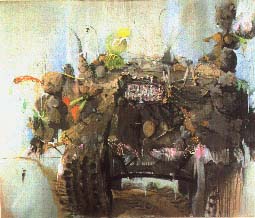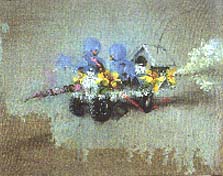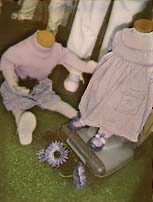
Margaret Curtis
Kuntry Matters
PPOW
532 Broadway, NYC
February 15-March 16,1996
Margaret Curtis does to a monster truck what Lori Petty was able to do to her supertank: she dresses it up. She takes you for a gender-hopping ride in which life-size Tonka trucks sprout ribbons, sugar-coated ice cream cones, and other assorted girlish frillery, right along with the piles of dirt they're transporting. These energetic paintings range the territory of the ironic decorative, with an acute awareness of gender identity, including a caterpillar who dresses up in a ribbon (a butterfly transvestite in the making), and a little girl in a satin bow (looking 4-H proud), posed and waving from the top of her bedecked cherry picker in matching pink satin fringe.
This girlish wit operates by revealing the maneuvers of Masquerade; it
exposes feminine frivolities as decorative trappings made to hide forbidden
conventional masculine ambitions (for instance: the desire to drive really
big trucks). Bows, little tweety birds, easter egg baskets, gingerbread
houses and other decorative doo-dads create a reassuring picture of
old-fashioned virtuous girlishness that is set awry by the massive big rigs
that support them. One such whimsical construction is aptly and humorously
titled "Float of the Diminutive Phallus".

Deftly employing a variety of painting methods, from explorative mark, through soaked raw linen to thick impasto, Curtis' imagery gains visual strength from the teasing out of countless small details. Gummy but scrupulously delineated flowers and gluey draped ribbons snap into focus against gray clouds of generalized soft matter and detritus. Curtis even uses cake decorating tools, a way to apply both paint and message, assuredly.
While all these embellishments serve up a festooned decorativeness, I wonder about the difference between approaching the history of decorative painting versus decorating a painting itself. While Dutch still lifes have much of the same abundance and framing, and Jugendstil design has a history of walking hand-in-hand with decorative art, these aren't the primary connections that I would make. This pictorial energy seems rather the end product of a mad Easter egg decorator. What is initially displayed as nature ends up attacked under an onslaught of a Hallmark madness, festooned and beribboned like children made presentable to the grandparents at holiday time.
While walking past the windows of Sixth Avenue, I was struck by the
similarity between her methodology and that of a good window dresser. At Old
 Navy, child mannequins in drab pastel clothing ride vacuum cleaners sucking
up plastic posies from the astroturf. At a nearby bicycle shop, a small pink
and purple three-speed glistens with plastic fringe shouting out its gender
affiliation: I am a GIRL'S bike!
Navy, child mannequins in drab pastel clothing ride vacuum cleaners sucking
up plastic posies from the astroturf. At a nearby bicycle shop, a small pink
and purple three-speed glistens with plastic fringe shouting out its gender
affiliation: I am a GIRL'S bike!
Exactly where, then, is the location of the decorative in these paintings: on
the surface, or in the tableaus presented? Perhaps both. Curtis offers the
viewer an exuberant rough-and-tumble romp, passing through the landscape of
the personal while chronicling an updated feminist tale of sugar and spice...
and everything's real nice.
-Angela Wyman
Email: ThingReviews
To post a response fill out the following form and click the "Submit" button. Or go back...
Scroll down to read messages.
ed --
Responds:
no art talent here
Mossy --
Responds:
Very nice writing, Tangle!
